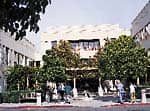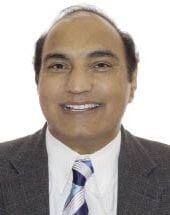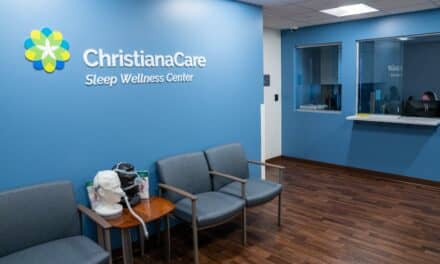Chicago’s Northwestern Memorial Hospital adds a second sleep center in the Radisson Hotel, providing patients with optimal privacy and a good night’s rest.

Establishing a sleep laboratory within a hotel—a very public place—can pose serious challenges when it comes to ensuring patient privacy as required under the Health Insurance Portability and Accountability Act. The sleep medicine team at Northwestern Memorial Hospital in Chicago recognized that, but did not let it deter them from opening a satellite facility across the street at a much-frequented Radisson Hotel.
“In this environment, privacy protection would be a concern from the moment patients arrived until the time they departed for home,” says Lan Ly, RPSGT, administrator of the Sleep Disorders Center. “We addressed this issue in part by leasing an entire floor of 13 rooms. Further, we arranged for our patients to enter the hotel not by way of its busy front lobby but by a less-used side door. We’re up on the 15th floor and, beginning at 11 o’clock nightly, we restrict elevator access—that also aids privacy, but, just as important, prevents hotel guests who otherwise might accidentally wander onto our floor from possibly disturbing the sleep of our patients.”
Despite the need for such privacy measures, setting up in the hotel was clearly a smart move for Northwestern. “We’re able to handle a lot more sleep studies now,” says Ly. “The maximum number of patients we’re equipped to handle per year is at present approximately 4,200. Currently, we perform, on average, 50 to 55 studies per week, or about 200 to 240 studies a month. In the 8 months between the start of fiscal 2005 in September until the end of April, we performed 1,764 studies. By the time our fiscal year concludes on August 31, we expect to complete another 736 studies, giving us a total of 2,500 for the full year.” And, if the trends hold, 90% of those studies this fiscal year will have been performed at the hotel.

Attractive Proposal
Located just north of Chicago’s famed Loop district, nationally recognized Northwestern Memorial Hospital is a major Midwest referral center. It is the primary teaching hospital of North-western Univer-sity’s Feinberg School of Medi-cine and is home to more than 1,400 phy-sicians representing virtually every specialty. With 2 million square feet of facility space, the hospital currently has licensed capacity for 744 beds.
The on-campus Sleep Dis-orders Center laboratory is situated on the hospital’s seventh floor, within the domain of the Neurological Testing Center. Six rooms designated for sleep studies surround a larger space in their midst, which serves as the control room.
The decision to add a second facility, the one at the Radisson Hotel, was reached in late 2002 when business projections pointed to a day no more than 5 years away when demand for sleep studies would overwhelm the ability of the hospital-based unit to keep pace.
“At the time, the average wait to get an appointment for a sleep study was already about 8 weeks,” Ly says. “If a patient was diagnosed with a disorder, it took at least another 3 weeks for a follow-up appointment to begin treatment. This was increasingly seen as unacceptable—physicians and patients alike were insisting on shorter waits. And if our volume-growth forecasts were right, then the waits would only grow longer.”
Along with that grim eventuality, satisfaction surveys the laboratory conducted revealed some patients were experiencing heightened anxiety during their stay in the Sleep Disorders Center. “Too clinical a setting” went the common refrain. “Patients did not feel like this was a true sleep environment,” Ly says. However, the notion of remodeling the laboratory to make it appear less sterile and more restfully inviting was a nonstarter because it represented an expense that would do nothing to relieve the backlog.
“The only way to solve the problem of long waits was with the addition of more beds,” Ly says. “Unfortunately, there was no available space in the hospital to permit an expansion. We looked at sharing space with other departments, but realized there would be major issues involving noise control, what with nurses making rounds, equipment alarms beeping, phones ringing, and all the clatter that normally goes on in a hospital at night.
“That’s when a couple of our people brought up the possibility of leasing space in a hotel. It was a very attractive proposal. In a hotel setting, we’d be able to provide the quiet comfort our patients needed and, at the same time, be able to quickly expand our operations without incurring any big expenses since little in the way of build-out would be required.”
Of the 13 rooms at the Radisson, 10 are designated for patients (one has been modified to provide wheelchair access in the bathroom) and the remaining three are operations-related (one houses the control room, another the office of the site administrator, and the last serves as a reception area).

Bedder Than Most
The Radisson site opened for business in March 2004, and gave Northwestern an immediate edge over other sleep laboratories in the Chicago market.
“Many other centers have only a hospital-based facility or a hotel-based facility, but not both as we do,” says neurologist Phyllis C. Zee, MD, PhD, medical director. “Two locations allow us to meet the diverse needs of our patient population—for example, we have patients who require intensive medical monitoring due to cardiopulmonary conditions and, for them, the most appropriate setting is the hospital.”
Northwestern decides which patients to assign to a bed in the hospital-based laboratory and which to a bed at the Radisson by posing two questions at the time a study is scheduled. Ly says, “When someone calls to make an appointment, we ask them if they can get in and out of bed by themselves and if they can lie on their back when sleeping. Answering no to either question suggests to us that the patient has mobility issues or a complex medical history or both. All such patients are automatically scheduled for study at our hospital location. Patients must answer yes to both questions in order to be scheduled at the hotel.”
Another marketplace advantage held by the Sleep Disorders Center is its ability to staff the two sites around the clock on weekdays and 16 hours a day on weekends.
“This makes it very easy to accommodate patients who work swing and graveyard shifts, patients who have atypical sleep schedules,” Ly says. “We can conduct studies based on the patients’ own reported bedtimes and rise times, rather than in accordance with our staff schedule.”
Both locations operate using a multidisciplinary model, and that is also a big plus. “We work with otolaryngologists, dentists, and others to address the diverse causes of sleep disorders.” Ly says. “We also work closely with our bariatric and anesthesiology programs.”
Notably, the Sleep Disorders Center’s four neurologists and two pulmonologists—its entire complement of physicians—are board-certified in sleep medicine, Zee offers.
“Having only boarded sleep physicians is important for a number of quality and safety reasons, but also for reasons that tie into our marketing,” she says. “For one, boarded sleep physicians are necessary to receive AASM accreditation. For another, it assures the health care consumer that, when they choose to come to us, they will be under the care of sleep physicians recognized by the sleep medicine profession as well trained and competent in dealing with sleep disorders.”

Cutting Edge
Patients feel good about coming to Northwestern’s Sleep Disorders Center for reasons beyond privacy, comfort, and quality: there is also the aspect of the enterprise being on the cutting edge of sleep medicine by dint of a vibrant research program. At present, there are two major research projects under way. The first deals with age-related changes in sleep and circadian rhythms.
“We’re looking at how those changes contribute to development of poor sleep and sleep disorders in the older population and how exercise can affect sleep for those who are elderly with chronic insomnia,” Zee says of the National Institutes of Health-funded endeavor. “What we’ve been able to demonstrate thus far is that older people who exercise in the morning or evening experience improved sleep quality, measured subjectively, and have improved cognitive function.”
The second of the two major studies (again NIH funded) focuses on the genetics and pathophysiology of circadian rhythm disorder in older and younger people, the causes of circadian rhythm disorders, and the efficacy of treatment with melatonin and other therapies.
“A paper of ours on this topic has been published in the journal Sleep and shows that melatonin is indeed effective in treating delayed sleep-phase syndrome,” Zee says.

The research opportunities for the Sleep Disorders Center could widen over time as the enterprise deepens its relationship with one of the country’s premier rehabilitation hospitals, the Rehabilitation Institute of Chicago (RIC). But whether jointly conducted research is in the cards, one thing is certain—RIC’s patient population will no longer be underserved when it comes to sleep medicine, promises Lisa Wolfe, MD, Sleep Disorders Center pulmonologist.
“We found that people with disabilities have limited access to sleep care,” says Wolfe. “Our goal is to change that. We believe sleep medicine should be widely available to promote overall health, especially for those with disabilities.”
Specifically, the Sleep Disorders Center wants to conduct studies at RIC through a collaborative effort so that patients with disabilities will not have to be transferred to the laboratory at Northwestern Memorial Hospital for testing.
“People with disabilities have transportation and medical needs that our sleep technologists are not trained to safely handle,” says Wolfe. “At RIC, we’ll be supported by clinicians who are.”
In addition to working with RIC clinicians, the Northwestern team will draw on the expertise of the rehabilitation hospital’s respiratory therapists.
“Because many of these patients have coexisting disorders, such as sleep apnea and respiratory failure, our vision is to have a registered respiratory therapist work in conjunction with a sleep technician to address both issues,” Ly says.
Regardless of condition, foremost among considerations for treating RIC patients will be their safety and comfort. Accordingly, the rooms for sleep studies will be as nonclinical as possible—though, admittedly, not quite as homey as the rooms at the Radisson Hotel. The checkout procedure the next morning will be somewhat different as well, obviously. Of course, no matter at which site a sleep study is performed—hotel or hospital—the most valuable thing a patient can leave with is confidence that his testing went without a hitch and will result in a reliable diagnosis leading to successful treatment. The Sleep Disorders Center at Northwestern Memorial Hospital is very good at making sure patients receive exactly those assurances.
Rich Smith is a contributing writer for Sleep Review.




![How a Sleep Lab Magnifies Success—By Sharing It [Editor’s Message]](https://sleepreviewmag.com/wp-content/uploads/2018/08/TouchetteCentrevillSleepLab-440x264.jpg)
